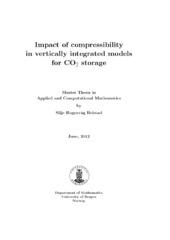Impact of compressibility in vertically integrated models for CO2 storage
Master thesis
Permanent lenke
https://hdl.handle.net/1956/6685Utgivelsesdato
2012-06-01Metadata
Vis full innførselSamlinger
Sammendrag
Recent work have shown that simplified models obtained by vertical integration give reasonable approximations for CO2 migration. Most of the work previously done on this topic assumes that CO2 is an incompressible fluid, or they work with a quasi compressibility, where they consider horizontal compressibility but not vertical. However, CO2 is highly compressible and large variations in CO2 density can be expected due to pressure increases near the injection well. In addition, long term CO2 migration to shallower depths can result in significantly lower density as dictated by geothermal gradients and regional pressure conditions. In this study, we outline the mathematical and numerical approach to solve the coupled vertically integrated models with density variation. Mathematical models for CO2 storage are considered in which the equations for mass conservation and Darcy's law are vertically integrated and coupled with an equation of state for CO2 density. Based on these, a pressure equation is derived. This pressure equation is then discretised with the use of an implicit control volume method and a partially implicit Lax-Friedrichs' method. A solution approach based on an IMPES approach is suggested. We have unfortunately not been able to solve this problem, as there has been some difficulties with the boundary values in the code, but we suggest a plan for further work for a working code.
